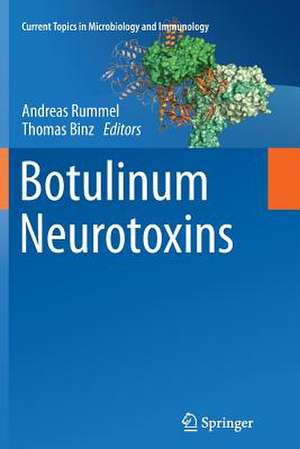Botulinum Neurotoxins: Current Topics in Microbiology and Immunology, cartea 364
Editat de Andreas Rummel, Thomas Binzen Limba Engleză Paperback – 29 ian 2015
| Toate formatele și edițiile | Preț | Express |
|---|---|---|
| Paperback (1) | 1159.36 lei 6-8 săpt. | |
| Springer Berlin, Heidelberg – 29 ian 2015 | 1159.36 lei 6-8 săpt. | |
| Hardback (1) | 1113.89 lei 6-8 săpt. | |
| Springer Berlin, Heidelberg – 14 dec 2012 | 1113.89 lei 6-8 săpt. |
Din seria Current Topics in Microbiology and Immunology
- 18%
 Preț: 962.03 lei
Preț: 962.03 lei - 5%
 Preț: 1123.13 lei
Preț: 1123.13 lei -
 Preț: 499.76 lei
Preț: 499.76 lei - 5%
 Preț: 967.79 lei
Preț: 967.79 lei - 18%
 Preț: 1118.62 lei
Preț: 1118.62 lei - 5%
 Preț: 717.00 lei
Preț: 717.00 lei - 5%
 Preț: 712.97 lei
Preț: 712.97 lei - 5%
 Preț: 709.51 lei
Preț: 709.51 lei - 5%
 Preț: 709.51 lei
Preț: 709.51 lei - 5%
 Preț: 721.19 lei
Preț: 721.19 lei - 5%
 Preț: 359.78 lei
Preț: 359.78 lei - 5%
 Preț: 711.88 lei
Preț: 711.88 lei - 5%
 Preț: 774.81 lei
Preț: 774.81 lei - 15%
 Preț: 640.06 lei
Preț: 640.06 lei - 5%
 Preț: 717.00 lei
Preț: 717.00 lei - 5%
 Preț: 360.34 lei
Preț: 360.34 lei - 5%
 Preț: 707.69 lei
Preț: 707.69 lei - 5%
 Preț: 717.56 lei
Preț: 717.56 lei - 5%
 Preț: 716.28 lei
Preț: 716.28 lei - 5%
 Preț: 717.20 lei
Preț: 717.20 lei - 5%
 Preț: 711.32 lei
Preț: 711.32 lei - 5%
 Preț: 711.88 lei
Preț: 711.88 lei - 5%
 Preț: 718.29 lei
Preț: 718.29 lei - 5%
 Preț: 709.51 lei
Preț: 709.51 lei - 5%
 Preț: 369.84 lei
Preț: 369.84 lei - 5%
 Preț: 712.25 lei
Preț: 712.25 lei - 5%
 Preț: 716.45 lei
Preț: 716.45 lei - 5%
 Preț: 706.60 lei
Preț: 706.60 lei - 5%
 Preț: 711.52 lei
Preț: 711.52 lei - 5%
 Preț: 713.54 lei
Preț: 713.54 lei - 5%
 Preț: 720.47 lei
Preț: 720.47 lei - 5%
 Preț: 725.42 lei
Preț: 725.42 lei - 5%
 Preț: 708.06 lei
Preț: 708.06 lei - 5%
 Preț: 713.70 lei
Preț: 713.70 lei - 5%
 Preț: 705.83 lei
Preț: 705.83 lei - 5%
 Preț: 710.96 lei
Preț: 710.96 lei - 5%
 Preț: 723.93 lei
Preț: 723.93 lei - 5%
 Preț: 707.69 lei
Preț: 707.69 lei - 5%
 Preț: 715.35 lei
Preț: 715.35 lei - 5%
 Preț: 709.87 lei
Preț: 709.87 lei - 5%
 Preț: 359.05 lei
Preț: 359.05 lei - 5%
 Preț: 374.20 lei
Preț: 374.20 lei - 15%
 Preț: 635.31 lei
Preț: 635.31 lei - 5%
 Preț: 707.86 lei
Preț: 707.86 lei - 5%
 Preț: 721.96 lei
Preț: 721.96 lei - 15%
 Preț: 632.88 lei
Preț: 632.88 lei - 15%
 Preț: 632.05 lei
Preț: 632.05 lei - 15%
 Preț: 642.83 lei
Preț: 642.83 lei - 5%
 Preț: 709.14 lei
Preț: 709.14 lei
Preț: 1159.36 lei
Preț vechi: 1220.37 lei
-5% Nou
Puncte Express: 1739
Preț estimativ în valută:
221.87€ • 229.21$ • 184.65£
221.87€ • 229.21$ • 184.65£
Carte tipărită la comandă
Livrare economică 25 martie-08 aprilie
Preluare comenzi: 021 569.72.76
Specificații
ISBN-13: 9783642448898
ISBN-10: 3642448895
Pagini: 324
Ilustrații: VIII, 324 p.
Dimensiuni: 155 x 235 x 18 mm
Greutate: 0.47 kg
Ediția:2013
Editura: Springer Berlin, Heidelberg
Colecția Springer
Seria Current Topics in Microbiology and Immunology
Locul publicării:Berlin, Heidelberg, Germany
ISBN-10: 3642448895
Pagini: 324
Ilustrații: VIII, 324 p.
Dimensiuni: 155 x 235 x 18 mm
Greutate: 0.47 kg
Ediția:2013
Editura: Springer Berlin, Heidelberg
Colecția Springer
Seria Current Topics in Microbiology and Immunology
Locul publicării:Berlin, Heidelberg, Germany
Public țintă
ResearchCuprins
Genetic Diversity Within Clostridium botulinum Serotypes, Botulinum Neurotoxin Gene Clusters and Toxin Subtypes.- Assembly and Function of the Botulinum Neurotoxin Progenitor Complex.- Uptake of Botulinum Neurotoxin in the Intestine.- Double Receptor Anchorage of Botulinum Neurotoxins Accounts for their Exquisite Neurospecificity.- The Elusive Compass of Clostridial Neurotoxins: Deciding When and Where to Go?.- Synchronized Chaperone Function of Botulinum Neurotoxin Domains Mediates Light Chain Translocation into Neurons.- Clostridial Neurotoxin Light Chains: Devices for SNARE Cleavage Mediated Blockade of Neurotransmission.- Synaptic Vesicle Proteins: Targets and Routes for Botulinum Neurotoxins.- Persistence of Botulinum Neurotoxin Inactivation of Nerve Function.- Structure-Based Drug Discovery for Botulinum Neurotoxins.- Complexity of Botulinum Neurotoxins: Challenges for Detection Technology.- Progress in Cell Based Assays for Botulinum Neurotoxin Detection.- Transforming the Domain Structure of Botulinum Neurotoxins into Novel Therapeutics.- Botulinum Toxin: Application, Safety, and Limitations.
Textul de pe ultima copertă
Botulinum neurotoxins are the most toxic natural substances and represent a major threat to the population when intentionally released in bioterrorist attacks. On the other hand, during the past two decades botulinum neurotoxins have become established as indispensable drugs for the treatment of a variety of severe neurological disorders. The need for efficient countermeasures as well as the expansion into additional fields of therapeutic application, call for comprehensive information on the botulinum neurotoxin molecules and their mode of action. Our knowledge of this subject has made great strides in recent years, setting the stage for the development of new botulinum neurotoxin-based molecules and novel applications.
This book reviews the current status of basic botulinum neurotoxin research. The first part describes the genetic variability of the toxin-producing bacteria, and sheds light on each step from toxin ingestion to the abrogation of synaptic signaling including the intestinal passage and absorption, nerve cell binding and entry, and intracellular substrate cleavage. The remaining chapters detail progress made in detection methods for botulinum neurotoxins, the development of botulinum neurotoxin inhibitors, and strategies to refine the neurotoxins for further medicinal applications by means of recombinant technologies.
This book reviews the current status of basic botulinum neurotoxin research. The first part describes the genetic variability of the toxin-producing bacteria, and sheds light on each step from toxin ingestion to the abrogation of synaptic signaling including the intestinal passage and absorption, nerve cell binding and entry, and intracellular substrate cleavage. The remaining chapters detail progress made in detection methods for botulinum neurotoxins, the development of botulinum neurotoxin inhibitors, and strategies to refine the neurotoxins for further medicinal applications by means of recombinant technologies.
Caracteristici
Written by leading experts in the field botulinum neurotoxins Provides the current status of basic botulinum neurotoxin research Provides in depth articles on neurotoxins for further medical applications by means of recombinant technologies Includes supplementary material: sn.pub/extras













